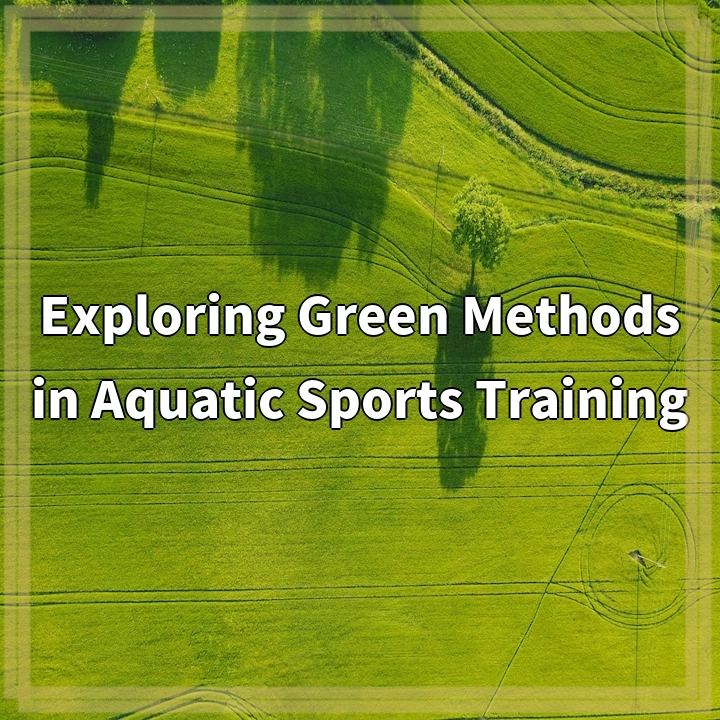
What it is:
Green methods in aquatic sports training refer to environmentally sustainable practices and techniques that are employed in the field of aquatic sports training. These methods aim to minimize negative impacts on the natural environment and promote a more eco-friendly approach to training athletes in water-based sports such as swimming, diving, water polo, and synchronized swimming. By adopting green methods, athletes, coaches, and sports organizations can contribute to the preservation of aquatic ecosystems and reduce their carbon footprint.
One of the main focuses of green methods in aquatic sports training is the use of environmentally friendly materials and equipment. This includes utilizing energy-efficient pool facilities, such as those powered by renewable energy sources or equipped with energy-saving technologies. Additionally, eco-friendly training equipment, such as biodegradable swim caps and recyclable swimming goggles, can be incorporated to minimize waste generation.
Real-world problems:
Despite the benefits of aquatic sports, there are several real-world problems associated with traditional training methods that have negative environmental implications. Here are some of the key challenges:
1. Water and energy consumption: Traditional aquatic sports training often requires large amounts of water and energy for pool maintenance, heating, and lighting. This can contribute to water scarcity and increase greenhouse gas emissions.
2. Chemical usage: Chemical disinfection methods, such as chlorine, are commonly used in pools to maintain water quality. However, the excessive use of chemicals can lead to water pollution and pose health risks to athletes and coaches.
3. Waste generation: Traditional aquatic sports training can result in significant waste generation, including plastic pollution from discarded equipment and single-use items. Improper waste management can further impact aquatic ecosystems and marine life.
4. Ecological disturbance: The construction and maintenance of pool facilities can cause ecological disturbance, such as habitat destruction and disruption of natural water flows. This can affect local biodiversity and ecosystems.
Addressing these real-world problems requires a shift towards green methods in aquatic sports training. By implementing sustainable practices, such as water and energy conservation, the use of eco-friendly materials, and proper waste management, the sports community can make a positive environmental impact and ensure the long-term sustainability of aquatic sports.

Solutions to Real-World Problems:
Addressing the environmental challenges associated with traditional aquatic sports training requires the adoption of sustainable solutions. Here are some key strategies to promote green methods in aquatic sports training:
1. Water and Energy Conservation:
Implementing water and energy-saving measures can significantly reduce the environmental impact of aquatic sports training. This can include using pool covers to minimize water evaporation, optimizing pool filtration systems for efficient water circulation, and utilizing renewable energy sources to power pool facilities.
2. Eco-Friendly Materials and Equipment:
Choosing eco-friendly training equipment and materials is crucial in minimizing waste generation. This can involve opting for biodegradable or reusable swim caps, environmentally friendly pool cleaning products, and recyclable swimming goggles. Additionally, promoting the use of sustainable swimwear made from recycled or organic materials can further contribute to eco-conscious practices.
3. Sustainable Chemical Usage:
Reducing the reliance on harsh chemicals for pool maintenance can help limit water pollution and protect the health of athletes and coaches. Exploring alternative disinfection methods, such as UV or ozone purification systems, can provide effective water treatment while reducing the use of chemicals.
4. Proper Waste Management:
Implementing comprehensive waste management systems can minimize the environmental impact of aquatic sports training. This includes promoting recycling programs for equipment, minimizing single-use plastic items, and ensuring proper disposal of hazardous materials. Additionally, raising awareness among athletes and coaches about the importance of responsible waste management can foster a culture of sustainability.
5. Sustainable Facility Design:
When constructing or renovating pool facilities, incorporating sustainable design principles can mitigate ecological disturbance. This can involve considering the surrounding ecosystem, minimizing habitat disruption, and incorporating natural filtration systems. Additionally, integrating renewable energy technologies, such as solar panels, can reduce the carbon footprint of the facility.















